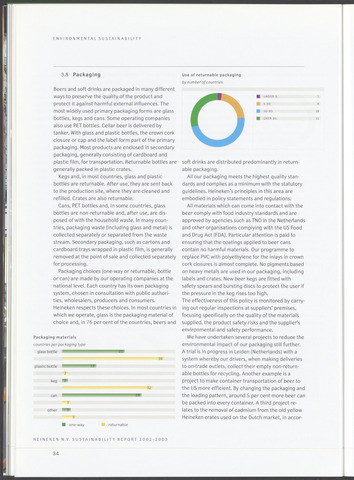ENVIRONMENTAL SUSTAINABILITY
3.8 Packaging
Beers and soft drinks are packaged in many different
ways to preserve the quality of the product and
protect it against harmful external influences. The
most widely used primary packaging forms are glass
bottles, kegs and cans. Some operating companies
also use PET bottles. Cellar beer is delivered by
tanker. With glass and plastic bottles, the crown cork
closure or cap and the label form part of the primary
packaging. Most products are enclosed in secondary
packaging, generally consisting of cardboard and
plastic film, for transportation. Returnable bottles are
generally packed in plastic crates.
Kegs and, in most countries, glass and plastic
bottles are returnable. After use, they are sent back
to the production site, where they are cleaned and
refilled. Crates are also returnable.
Cans, PET bottles and, in some countries, glass
bottles are non-returnable and, after use, are dis
posed of with the household waste. In many coun
tries, packaging waste (including glass and metal) is
collected separately or separated from the waste
stream. Secondary packaging, such as cartons and
cardboard trays wrapped in plastic film, is generally
removed at the point of sale and collected separately
for processing.
Packaging choices (one-way or returnable, bottle
or can) are made by our operating companies at the
national level. Each country has its own packaging
system, chosen in consultation with public authori
ties, wholesalers, producers and consumers.
Heineken respects these choices. In most countries in
which we operate, glass is the packaging material of
choice and, in 76 per cent of the countries, beers and
Use of returnable packaging
by number of countries
Packaging materials
countries per packaging type
glass bottle
plastic bottle
keg
36
32
other
UNDER 5
5-50
50-95
OVER 95
5
one-way
soft drinks are distributed predominantly in return
able packaging.
All our packaging meets the highest quality stan
dards and complies as a minimum with the statutory
guidelines. Heineken's principles in this area are
embodied in policy statements and regulations.
All materials which can come into contact with the
beer comply with food industry standards and are
approved by agencies such as TNO in the Netherlands
and other organisations complying with the US Food
and Drug Act (FDA). Particular attention is paid to
ensuring that the coatings applied to beer cans
contain no harmful materials. Our programme to
replace PVC with polyethylene for the inlays in crown
cork closures is almost complete. No pigments based
on heavy metals are used in our packaging, including
labels and crates. New beer kegs are fitted with
safety spears and bursting discs to protect the user if
the pressure in the keg rises too high.
The effectiveness of this policy is monitored by carry
ing out regular inspections at suppliers' premises,
focusing specifically on the quality of the materials
supplied, the product safety risks and the supplier's
environmental and safety performance.
We have undertaken several projects to reduce the
environmental impact of our packaging still further.
A trial is in progress in Leiden (Netherlands) with a
system whereby our drivers, when making deliveries
to on-trade outlets, collect their empty non-return
able bottles for recycling. Another example is a
project to make container transportation of beer to
the US more efficient. By changing the packaging and
the loading pattern, around 5 per cent more beer can
be packed into every container. A third project re
lates to the removal of cadmium from the old yellow
Heineken crates used on the Dutch market, in accor-
returnable
HEINEKEN N.V. SUSTA INABILITY REPORT 2002-2003
34

